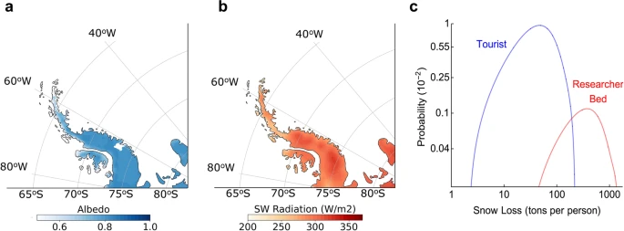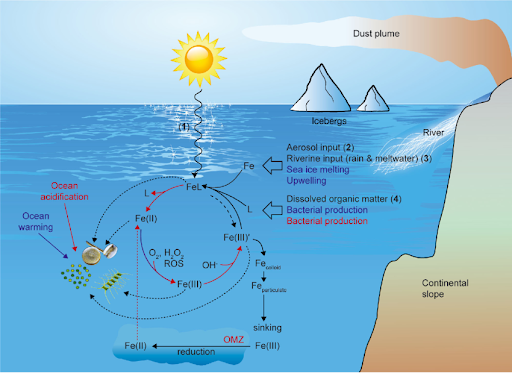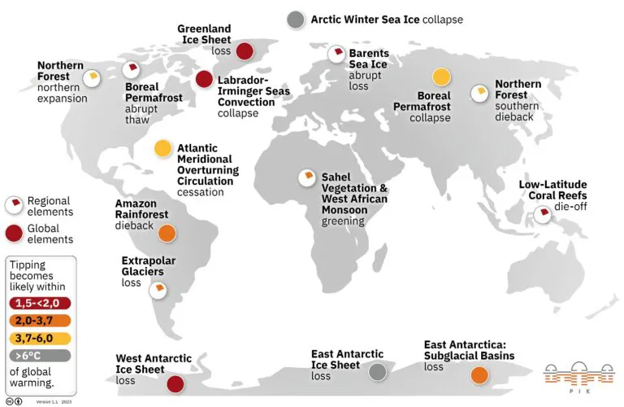24 Oct to 10 Nov, 2024
CLIMATE CHANGE AND DISPROPORTIONATE IMPACT
Why in the news ? : Food and Agriculture Organization (FAO) has reported that poor households globally lose an average of 5% of their total income each year due to heat stress and 4.4% due to floods.
About :
Global average temperatures have already risen by approximately 1.1°C above pre-industrial levels, according to the IPCC’s 2021 report. The frequency of extreme weather events—heatwaves, floods, hurricanes, and droughts—has intensified. A 2020 World Bank report estimated that climate change could push over 130 million people into poverty by 2030, disproportionately impacting low-income populations that contribute the least to global emissions yet face the brunt of its effects.
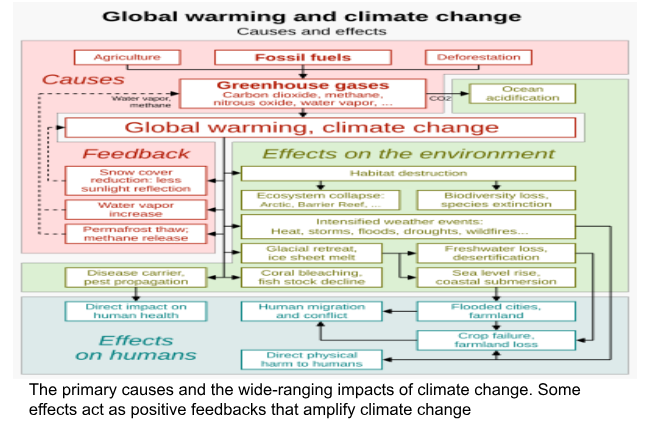
Impact of Climate change on Poor people
- Economic Impacts: Climate-related losses in agriculture, fisheries, and livestock affect poor communities reliant on these sectors, reducing household income and increasing vulnerability.Example: A 2018 study by the World Bank reported that climate impacts could reduce GDP by up to 6% in regions like Sub-Saharan Africa.
- Health Impacts: Rising temperatures and extreme weather events worsen health conditions in impoverished areas, where people have limited access to healthcare, sanitation, and clean water. Example: In Kenya, prolonged droughts have worsened malnutrition rates, affecting nearly 2.7 million children.
- Food Security: Poorer communities are vulnerable to food shortages caused by crop failure and increased food prices, which are projected to rise by up to 30% by 2050 due to climate factors. Example: In Yemen, climate-induced droughts have worsened the existing food crisis, affecting 50% of the population.
- Social Displacement: Climate displacement forces millions from their homes, with limited resources to secure new livelihoods, increasing poverty rates in urban areas.Example: In the Marshall Islands, rising sea levels are forcing inhabitants to migrate, disrupting traditional lifestyles and cultural ties.
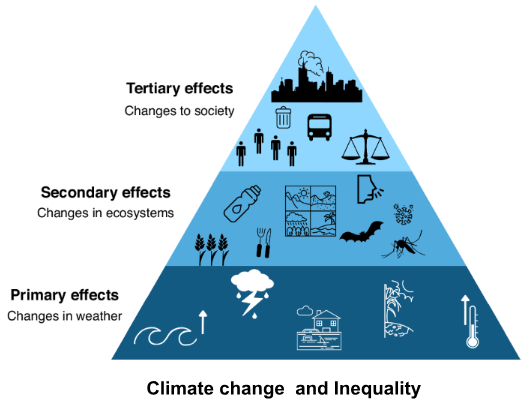
Case Study: Cyclone Idai and Mozambique’s Vulnerable Populations
Cyclone Idai, one of the most devastating storms to hit Southern Africa, struck Mozambique in 2019, leading to massive flooding and destruction. The storm caused approximately 1,300 fatalities, destroyed over 90% of Beira city, and affected nearly 1.8 million people. The storm’s impact on Mozambique—a country where nearly 50% of the population lives in poverty—has deepened economic hardship, disrupted livelihoods, and increased food insecurity. Recovery has been slow due to limited infrastructure and resources, exacerbating vulnerability to future climate events.
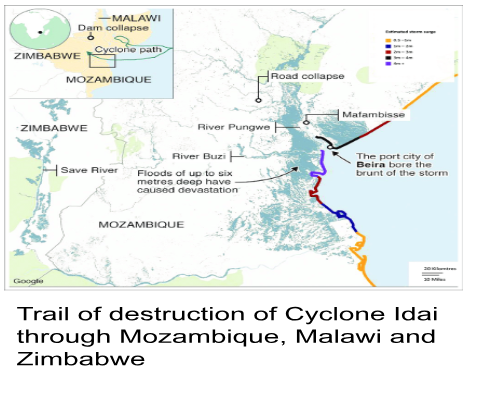
Impact of Climate Change ( Wealthy Vs Poor )
|
Effect on Rich |
Effect on Poor |
|
|
Economic Resilience and Recovery |
After Hurricane Harvey in 2017, Texas allocated over $5 billion for flood infrastructure and recovery, which cushioned the economic impact on wealthy neighborhoods. |
In Mozambique, Cyclone Idai (2019) caused $2 billion in damages—equal to nearly 10% of the country’s GDP. With limited external aid, many affected communities remain in poverty due to slow recovery. |
|
Health Vulnerabilities and Healthcare Access |
In France, which has a strong healthcare system, heat adaptation policies like public cooling centers have minimized fatalities during heatwaves. |
During India’s 2019 heatwave, many low-income regions saw surging cases of heatstroke and dehydration, with reported fatalities largely from poorer areas that lack air conditioning and healthcare facilities. |
|
Living Conditions and Housing Stability |
In Miami, many luxury properties are equipped with flood barriers and hurricane-resistant structures to mitigate the effects of rising sea levels. |
In Dhaka, Bangladesh, slum communities on flood-prone land experience annual displacement due to flooding, worsening poverty as they lose homes and livelihoods. |
|
Food Security and Agricultural Impacts |
Rich countries like USA have diversified food sources and imports, mitigating the effects of crop failures or price hikes |
In Sub-Saharan Africa, where over 70% of people depend on rain-fed agriculture, unpredictable rainfall due to climate change leads to food scarcity, malnutrition, and price spikes that deepen poverty |
|
Adaptive Capacity and Policy Influence |
Cities like New York have invested in multi-billion-dollar seawalls and flood control systems to counter rising sea levels. |
In countries like Tuvalu , where resources for climate adaptation are scarce, hurricanes frequently devastate local infrastructure, with the poorest facing repeated setbacks. |
Environmental Justice and Climate Equity
- Wealthier communities often exert greater influence over environmental policies, securing more resources for mitigation, while poorer populations bear the brunt of pollution and climate risks with limited means to influence policy.
Intergenerational Inequality and Climate Change
- Intergenerational inequality refers to the unequal climate burden that younger and future generations will inherit due to current carbon emissions and unsustainable practices.
Educational Disparities and Climate Awareness
- Climate awareness programs in Scandinavian schools have fostered climate-conscious behavior from an early age, while in many impoverished regions, limited education reduces climate resilience.
Key Findings of the FAO Study 2023
- Income Loss from Heat and Floods: Globally, poor households lose about 5% of their income each year due to heat stress and 4.4% due to flooding events.
- Structural Inequalities: The report indicates that structural inequalities increase the vulnerability of poor households to climate stress, worsening income inequalities.
- Effect on On-Farm Income: In India, climate stress affects rural households' farm income differently based on the type of climate event. During droughts and similar stressors, poor households are compelled to focus more on agricultural activities as off-farm job opportunities diminish.
- Reduced Total Income: Households exposed to significant climate stress tend to have lower total income compared to those less affected.
Policy Recommendations for Mitigating Impact
- Expand Social Security: The report recommends widening the social security network to cushion poor farmers against the financial impacts of climate stressors.
- Anticipatory Social Protection: Strengthening social protection programs to anticipate extreme weather events can reduce dependence on negative coping mechanisms and prevent climate-induced poverty.
- Workforce Diversification: Expanding employment opportunities outside agriculture and reducing gender barriers in non-farm sectors can help build economic resilience.
Government Response and Initiatives
- National Innovations on Climate Resilient Agriculture (NICRA): Launched by the Indian Council of Agricultural Research (ICAR) in 2011, NICRA aims to boost the resilience of Indian agriculture against climate change and vulnerability through targeted research and technological solutions.
- Contingency Plans and Employment Schemes: India has contingency plans in place for every agricultural district and was a pioneer in implementing an employment guarantee scheme as a social safety net for farmers.
Conclusion
For equitable climate resilience, it is essential to adopt inclusive policies, such as climate finance for developing nations, capacity-building in vulnerable communities, and proactive measures to ensure access to green technology and resilient infrastructure across socio-economic strata.
Where to use :
Paper I ( Geography optional ) : Climate change , Environmental Education
Paper III ( General Studies ) : Climate change and impact on the poor.
Source :
Guidelines to Curb Greenwashing
Why in news : The Government has released guidelines to curb Greenwashing by companies and make it mandatory for companies to substantiate their claims with scientific evidence.
About :
Greenwashing refers to an increasing trend where companies, organizations, or even governments make questionable or unverifiable claims about their activities, products, or services being climate- or eco-friendly.
- The discourse around climate change and the urgency for climate action has heightened the pressure on corporations and governments to adopt environmentally responsible practices. In many cases, governments are bound by legal commitments to pursue such efforts.
- As a result, companies and governments may make claims that are exaggerated, misleading, or even false.
- Companies like Volkswagen (which falsified emissions data), Shell, British Petroleum, and Coca-Cola have all faced allegations of greenwashing.
- Countries have also exaggerated claims about the carbon absorption potential of their forests. Additionally, carbon trading mechanisms have been criticized for using flawed methods to generate carbon credits and for transferring emissions responsibilities from developed to developing nations rather than reducing emissions.
About the Guidelines
The Central Consumer Protection Authority has issued guidelines to address greenwashing in product and service advertising.
- Greenwashing is defined as any deceptive or misleading practice that hides or omits relevant information, exaggerates, or makes vague, unsubstantiated environmental claims about a product or service.
- Using misleading words, symbols, or imagery that highlight positive environmental attributes while downplaying or concealing negative aspects also qualifies as greenwashing.
- The guidelines permit “obvious hyperboles” or “puffery”—which are common in advertising—as long as they don’t result in deception or misleading practices.
- Generic terms such as ‘clean,’ ‘green,’ ‘eco-friendly,’ ‘good for the planet,’ ‘cruelty-free,’ ‘carbon neutral,’ ‘natural,’ ‘organic,’ and ‘sustainable,’ among others, will only be allowed if companies can substantiate these claims with evidence.
- This evidence may include credible certifications from statutory or independent third-party sources or reliable scientific proof.
- If technical terms such as “environmental impact assessment,” “greenhouse gas emissions,” or “ecological footprint” are used in advertisements, companies must explain these terms in a “consumer-friendly” language.
- These guidelines apply to all environmental claims made by manufacturers, service providers, or traders, as well as to advertising agencies and endorsers who promote such claims.
- The new guidelines are intended to complement the existing 2022 Guidelines for Prevention of Misleading Advertisements and Endorsements, which address false or exaggerated claims in general advertising.
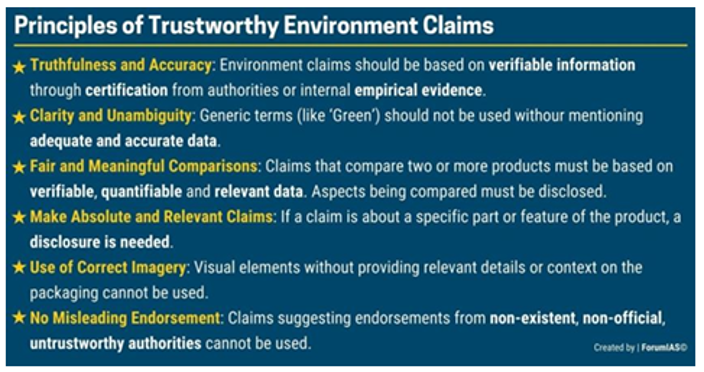
Recommendations of the UN Expert Group
The UN has established a high-level expert group to recommend measures to curb greenwashing by non-state entities, such as corporations, financial institutions, and cities, with net-zero commitments.
- Corporations aiming for net-zero targets should be prohibited from making new investments in fossil fuels.
- They should also be required to present short-term emission reduction targets as part of their net-zero plans.
- All deforestation-related activities must be discontinued by corporations pursuing net-zero goals.
- Corporations are advised against using offset mechanisms in the initial stages of their journey towards net-zero emissions.
Where to use ?
Paper I ( Geography Optional ) : Environmental Geography
Paper III ( General Studies ) : Environmental laws and acts
Source :
Twilight Zone in Oceans
Why in news : Recent evidence suggests that there are more animals in Twilight Zone of the oceans (by weight) than in all the world’s fisheries combined.
About:
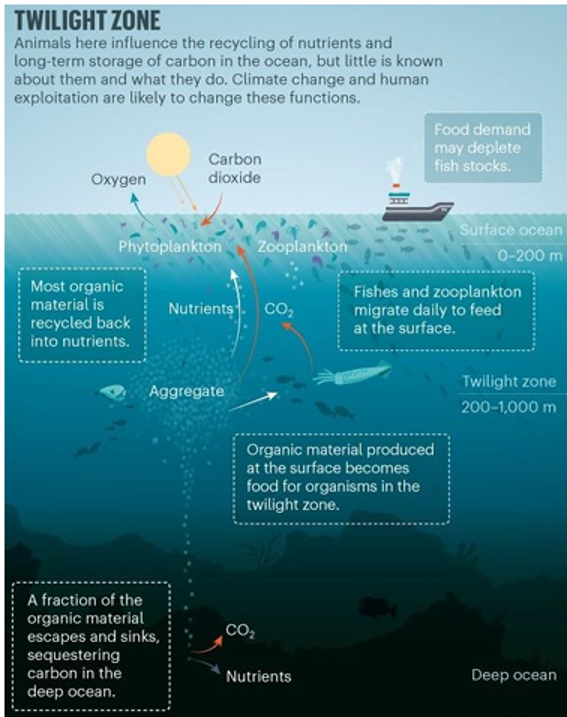
Twilight Zone in the Oceans
- Definition and Location: Known as the Mesopelagic Zone, the Twilight Zone sits between the sunlit Epipelagic Zone and the darker Bathypelagic Zone.
- Depth Range: This zone extends from approximately 200 meters to 1,000 meters below the ocean surface. Sunlight is minimal here, creating a dim, shadowy area that gives it the name "twilight."
- Light Penetration: Only a small amount of sunlight penetrates this layer, gradually decreasing with depth. It is not entirely dark, but the low light levels prevent photosynthetic organisms from thriving.
- Temperature and Pressure: Temperatures in the Twilight Zone are significantly cooler than at the surface, ranging from 4°C to 20°C. Pressure also rises sharply with depth, requiring unique adaptations among resident species.
- Oxygen Levels: Oxygen concentration is relatively low in this zone, especially in deeper areas, posing challenges for marine organisms adapted to low-oxygen environments.
- Marine Life: Despite harsh conditions, the Twilight Zone supports a diverse range of organisms. Many species, such as lanternfish, bristlemouths, squids, jellyfish, and zooplankton, have evolved specific adaptations for survival here.
- Bioluminescence: Some animals are bioluminescent, producing light via chemical reactions within their bodies. This ability aids in communication, hunting, and camouflage in the dim environment of the twilight zone.
- Diel Vertical Migration: In a process known as diel vertical migration, large numbers of creatures ascend from the twilight zone to the surface at night to feed, then return to avoid predators during daylight hours.
- Role in the Carbon Cycle: The twilight zone is vital to the global carbon cycle. Marine life, especially zooplankton and small fish, consume phytoplankton near the surface and transport carbon to deeper waters when they release waste or die and sink to the ocean floor.
Where to use ?
Paper I ( Geography Optional ) : Oceanography
Paper I ( General Studies ) : Marine resources
Source :
Diatoms
Diatoms: Diatoms are microscopic, single-celled algae with silica-based cell walls, commonly found in oceans, rivers, and lakes. They play a crucial role in aquatic ecosystems, producing nearly 20% of the world's oxygen and forming the base of many food webs. Diatoms also help sequester carbon, contributing to global carbon cycling.
Zombie Fire
Zombie Fire: Also called "holdover fires" or "overwintering fires," zombie fires are wildfires that survive beneath the snow and reignite in spring. This phenomenon is common in Arctic regions and results from smoldering peat layers that resist cold, creating a major risk for wildfire spread and contributing significantly to carbon emissions in the boreal and tundra regions.
Cold Edge Limit
Cold Edge Limit: The cold edge limit refers to the geographic or climatic boundary beyond which certain species or ecosystems cannot survive due to low temperatures. This boundary helps determine species distribution, particularly for those sensitive to cold, and is increasingly shifting poleward due to climate change.
Night Sky Sanctuary
Night Sky Sanctuary: A Night Sky Sanctuary is a designated area with exceptionally clear, dark skies protected from light pollution, ideal for stargazing and astrophotography. Recognized by organizations like the International Dark-Sky Association, these sanctuaries are often in remote locations and aim to preserve natural night environments for scientific, educational, and recreational purposes.
Blue Hole
Blue Hole: A blue hole is a large marine sinkhole or underwater cave, usually found in coastal areas or oceanic islands. Known for their deep blue appearance, these formations have steep drops and unique ecosystems, offering insights into past climate conditions and biodiversity. The Great Blue Hole in Belize is one of the most famous examples.
CLIMATE INDUCED MIGRATION - SAGAR ISLAND
Sunderbans, home to about 4.5 million people, is facing the unprecedented wrath of natural calamities , owing to recurring Cyclones like Amphan, sea level rise ( 3.14mm per year ) , salt water intrusion and tidal surges. Such environmental disasters have already pushed 69000 residents to mainland India and Bangladesh. Inadequate income opportunities, exploitation by money lenders, damage to weak infrastructure , rice and betel cultivation impact due to soil salinity combined together results in climate induced migration.

Source :
https://www.dw.com/en/forgotten-people-sundarbans-climate-refugees-forced-to-move-again/a-61162969
Where to use :
Paper I ( Population Geography ) : Migration
Paper III ( General Studies ) : Environment disasters
Places in News - 10 November 2024
1. Jayamangali River
Why in news : Recently, a team of arachnologists (those who study spiders and other arachnids) has identified a new genus of jumping spiders named ‘Tenkana,’ in the river .
- Jayamangali river is formed by the merger of its two tributaries Jaya and Mangala, both originating in Devarayanadurga, at Irksandra in Koratagere taluk of Tumkur district .
- It enters Parigi in Anantapur district of Andhra Pradesh and joins Penna river near Hindunpur and flows into Penna Ahobilam .
- The river is facing threat of drying up due to continuous over exploitation of groundwater table.
2. Nallamalla
Why in news : Chenchus tribe of Nallamalla have been caught at the cross fire between Maoists and the anti naxal forces of Andhra Pradesh police.
- The Nallamala Hills, often spelt Nallamalai, are a mountain range in India's eastern Andhra Pradesh and western Telangana.
- The rocks of the Nallamala ranges belong to the Kadapa system which is a series some 20,000 ft. thick.
- The Nallamalas have a rather warm to hot climate throughout the year. Rainfall averages about 90 cm and is concentrated in the months of the Southwest monsoon (June–September).
- Approx : Kurnool
3. Burtse
Why in news : Geologist finds marine fossils at icy heights in Burtse
- Burtsa, alternately spelled as Burtse, is a historic halting spot on the caravan route at the southern end of the Depsang Plains, where the Depsang Nala joins the Burtsa Nala.
- It currently serves as a military camp of the Indo-Tibetan Border Police (ITBP) and the Indian Army on the Darbuk-Shyok-DBO road, about 15 kilometres on the India's side of the LAC.
- North of Burtsa is Qizil Langar, also called Qazi Langar.
- Approx : Depsang Plains
4. Palghar
Why in news : A fisherman from Maharashtra’s Palghar district was attacked by a bull shark in the Vaitarna river.
- Palghar is a town in the Konkan division of Maharashtra state, India and a municipal council.
- Palghar lies on the Western Line of the Mumbai Suburban Railway in the busy Mumbai-Ahmedabad rail corridor.
- Vadval is the most numerous community present in Palghar. They are said to be the descendants of Yadava dynasty of Devagiri
- The Koli (fishermen) community of Palghar is a reminder of the city's links with the Arabian sea.
- Approx : Mahabaleshwar
5. Ponmudi hills
Why in news : A team of researchers has recently discovered a new species of damselfly at the Ponmudi hills in Thiruvananthapuram district of Kerala.
- Ponmudi translates to ‘Golden Hill’ or ‘Golden Peak’ is located in the state of Kerala
- It is located in the state of Kerala. It is part of the Western Ghats mountain range.
- The hills are a part of the Agasthyamalai landscape, at the southernmost tip of the Western Ghats.
- These hills are biodiversity-rich, and recently the third species of damselfly has been discovered from this region.
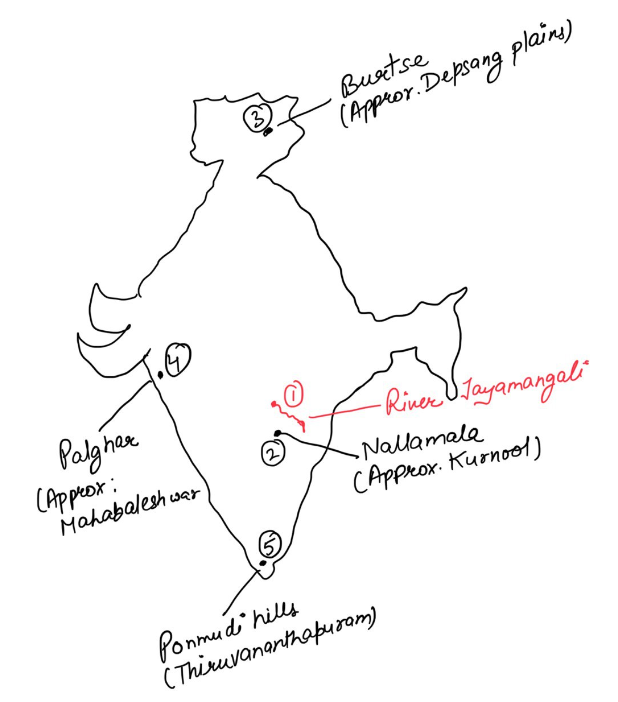
Fortnightly KOSMOS MCQs Practice - 10th November 2024
Q1. With reference to Living Planet Report 2024, consider the following statements:
- It is an annual report released by the Indian Environmental Society (IES).
- It reveals a drastic 73% drop in the average size of monitored wildlife populations over the last 50 years.
Which of the statements given above is/are correct?
- 1 Only
- 2 Only
- Both 1 and 2
- Neither 1 nor 2
Q2. Consider the following statements regarding Kunming-Montreal Global Biodiversity Framework (KMGBF),
- It aims to restore at least 30% of degraded terrestrial, inland water, and marine and coastal ecosystems by 2030.
- The target emphasizes collective global efforts rather than requiring individual countries to allocate specific land and water areas.
Which of the statements given above is/are correct?
- 1 Only
- 2 Only
- Both 1 and 2
- Neither 1 nor 2
Q3. Consider the following statements related to the methane cycle:
- Methanogens produce more methane than methanotrophs can consume.
- Methanotrophs reside in drier, oxygen-rich upper soil layers.
- The primary method for removing methane from Earth’s atmosphere is oxidation in the exosphere.
How many of the above statements is/are correct?
- Only one
- Only two
- All three
- None
Q4. Consider the following statements regarding cobalt mining:
- The Democratic Republic of Congo is the largest producer of cobalt.
- Cobalt mining has been linked to both environmental degradation and social issues.
- Cobalt mining also involves significant amounts of uranium, which poses additional environmental challenges.
Which of the above statements is/are correct?
- 1 and 2 only
- 2 and 3 only
- 1 and 3 only
- 1, 2, and 3
Q5. In 2024, which of the following geographical phenomena was observed in the high Arctic regions affecting polar bears?
- Formation of ice buildup on the feet of polar bears.
- Increase in the polar bear population due to milder winters.
Select the correct answer using the code given below:
- 1 only
- 2 only
- Both 1 and 2
- Neither 1 nor 2
Q6. Consider the following statements about global plastic waste:
- The world generates approximately 300 million tonnes of plastic waste annually.
- About 14 million tonnes of plastic enter the oceans each year, affecting marine life.
- In 2023, global efforts reduced plastic waste by 20%.
Which of the statements given above is/are correct?
- 1 and 2 only
- 2 and 3 only
- 1 and 3 only
- 1, 2, and 3
Q7. Which of the following were identified as significant contributors to air pollution and associated health risks in 2024?
- Particulate matter (PM2.5)
- Ozone layer depletion
- Increase in renewable energy sources
- Industrial emissions
Select the correct answer using the code given below:
- 1, 2, and 3 only
- 1 and 4 only
- 2, 3, and 4 only
- 1, 3, and 4 only
Q8. Consider the following statements regarding climate change events:
- The year 2023 was recorded as the hottest year on record globally.
- The increase in temperature was significantly due to El Niño events in 2023.
Which of the statements given above is/are correct?
- 1 only
- 2 only
- Both 1 and 2
- Neither 1 nor 2
Q9. Consider the following statement about the migratory birds mentioned in the context of Indian wetlands?
- The Siberian crane, predominantly found in East Asia, is listed as Critically Endangered by the IUCN.
- Known for their vibrant pink feathers, Lesser flamingos are classified as Near Threatened by the IUCN.
- Great white pelicans, identifiable by pink skin patches around their eyes, are categorized as Endangered on the IUCN Red List.
Which of the statements given above is/are correct?
- 1 and 2 only
- 2 only
- 1 and 3 only
- 1, 2, and 3
Q10. Consider the following statements related to Fungi:
- They are eukaryotic, non-phototrophic organisms.
- They have a unique cell wall composed of chitin.
- They reproduce only through asexual means.
How many of the above statements is/are correct?
- Only one
- Only two
- All three
- None
Share the article
Edukemy’s Current Affairs Quiz is published with multiple choice questions for UPSC exams
MCQ
Get Latest Updates on Offers, Event dates, and free Mentorship sessions.

Get in touch with our Expert Academic Counsellors 👋
FAQs
Geography Current Affairs focuses on the contemporary issues, events, and developments in the field of geography. It covers recent geographical phenomena, environmental changes, geopolitical shifts, and related news. This differs from regular geography studies which may focus more on foundational concepts, historical contexts, and theoretical frameworks.
Updates are provided regularly to ensure that subscribers stay informed about the latest developments in geography. Typically, updates are provided on a fortnightly basis, depending on the frequency of significant events and changes in the field.
Absolutely. Geography Current Affairs serves as a valuable resource not only for Geography optional but also for GS papers, especially GS Paper 1 (covering Indian Heritage and Culture, History, and Geography of the World and Society) and GS Paper 3 (covering Technology, Economic Development, Biodiversity, Environment, Security, and Disaster Management). It aids in building a holistic understanding of various topics and strengthens answer-writing skills by incorporating contemporary examples and perspectives.
Geography Current Affairs holds immense importance for UPSC preparation, particularly for aspirants opting for Geography optional. It helps candidates stay updated with the latest developments, geographical phenomena, environmental issues, and geopolitical shifts worldwide, aligning them with the dynamic nature of the subject as tested in the UPSC examinations.

